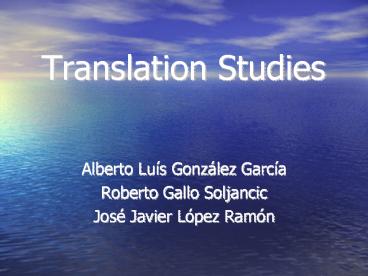Translation Studies - PowerPoint PPT Presentation
1 / 16
Title:
Translation Studies
Description:
Translation Studies Alberto Lu s Gonz lez Garc a Roberto Gallo Soljancic Jos Javier L pez Ram n Outline Introduction: Translation definition. – PowerPoint PPT presentation
Number of Views:72
Avg rating:3.0/5.0
Title: Translation Studies
1
Translation Studies
- Alberto Luís González García
- Roberto Gallo Soljancic
- José Javier López Ramón
2
Outline
- Introduction
- Translation definition.
- Translation vs. Interpretation.
- The role of translator skills.
- Translation Process specifically the different
stages carried out when translating. (According
to García Yebra). - Comprehension stage
- Expression stage
- Type of translation
- Direct vs. inverse Translation.
- Specialized vs. Non-specialized Translation.
3
Outline (II)
- Translation techniques (According to Vinay and
Darbelnet) Morphosyntactic Level - Loan word
- Calque
- Literal Translation
- Transposition
- Equivalence
- Adaptation
- Modulation
- Semantic Level
- Expansion
- Reduction
- Compensation
- Translation as a tool in SLT/ SLL.
4
Introduction
- Definition of Translation
- Munday the process of turning an original or
"source" text into a text in another language. - Translation vs. Interpretation
- Translation ---gt written texts
- Interpretation ---gt uses oral channel
5
- 1.3 The role of a translator skills
- What do you need to become a good translator?
- 1. Complete knowledge of both source and target
speech. - 2. Write appropiately in both source and target
language. - 3. Ability to have language intuition to grasp
various expressions, idioms and specific
vocabulary and their uses - 4. Be aware of the cultural divergence and
diverse strategies in the source and target
verbal communication - 5. Be aware of diverse registers, styles of
speaking, and social stratification of both
source and target language. - 6. You have to be provided with encyclopedias and
bilingual dictionaries in a specific context - 7. You have to take control of the different kind
of speeches in both source and target language.
6
Translation Process
- Garcia Yebra
- Two stages
- Comprehension stage The translator decodes the
sense of the source text into an activity called
semasiology. - Expression stage recodes the sense of the text
in the target language.
7
Type of translation
- Direct vs. indirect Translation
- Direct Translating from a foreign language into
your mother tongue. Example a Spanish translator
who translates from English into Spanish. - Indirect Translating from your mother tongue
into a foreign one. Example a Spanish translator
who translate from Spanish into English.
8
Type of translation
- Specialized vs. Non-specialized Translation.
- Specialized The translator requires an excellent
quality and precision into an area of knowledge.
Examples medical translation legal translation. - Non-specialized It is not required a great
knowledge in the area to translate.
9
Translation techniquesThe explanation of each
procedure, according to Vinay and Darbelnet
- Two levels Morphosyntax level and Semantic
level. - Morphosyntax level techniques
- -Loan Word A word taken from a language without
translating it Coyote (from Spanish), Pizza
(from Italian) - -Calque A class of loan where syntax is taken
from source language and translated literally.
English week-end Spanish fin de semana.
English science-fiction. Spanish
ciencia-ficción. Sangre azul ? Blue-blood - -Literal Translation translating word by word
from source to target language, respecting the
collocations of the target language. English You
are rich. Spanish Tú eres rico.
10
Translation techniques (II)
- Transposition Translating one part of the speech
to other one, without changing the sense of the
message. English out of order. Spanish no
funciona. Le gusta nadar ? She likes swimming. - Modulation Variation of the message, through a
change in the point of view. English Puzzle.
Spanish Rompecabezas. You can have it ? Te lo
dejo.
11
Translation techniques (III)
- Equivalence Transmiting the same situation by
using different stylistic and structural
resources. English no right of way. Spanish
prohibido el paso. The Sound of Music ? Sonrisas
y Lágrimas. - Adaptation Cultural equivalence. E.G.French
talking about Belgian jokes ? English talking
about Irish jokes.
12
Translation techniques (IV)
- Semantic Level
- Expansion needed amplification for structural
reasons. Example in Spanish is needed to specify
the gender. - Reduction the same as expansion, but it is
needed a reduction. - Compensation combination of the other two
techniques. Tu/Usted (Sp.) ? You (Eng.)
13
Translation as a tool for SLT/SLL
- SLL is the process by which people learn a second
language. - Translation is teached as a separated skill from
L2 acquisition, as first, you have to master L2
to be a good translator.
14
Conclussion
- Remind some especifit terms
- Difference between translation and interpretation
- Different kind of translation
- Loan words
- Calque
- Etc.
- Specific vs non-specific translation
15
- Thank you very much for your attention!
16
References
- www.translationcentral.com/translation_vs_interpre
tation.php - http//ezinearticles.com/?What-Skills-Are-Required
-To-Be-A-Good-Translator?id911804 - http//www.ruf.rice.edu/kemmer/Words/loanwords.ht
ml - http//www.translationschools.org/translation/spec
ialized/ - López Guix, J.G. Wilkinson, J.M. (1997). Manual
de traducción inglés-castellano. Teoría y
práctica. Gedisa - http//www.jstor.org/pss/392747
- http//people.umass.edu/bparient/Research/Complete
Thesis-BeatrizParienteBeltran.pdf - logos.uoregon.edu/research/second_language.shtml
- http//isg.urv.es/publicity/masters/sample/techniq
ues.html - en.wikipedia.org
- Stibbard, R. (1994). The Study of Translation in
a Foreign Language Teaching. Perspectives
Studies in Translatology. - Cordero, A.D. (1984). The Role of Translation in
Second Language Acquisition. The French Review,
Vol. 57, No. 3, pp. 350-355.

